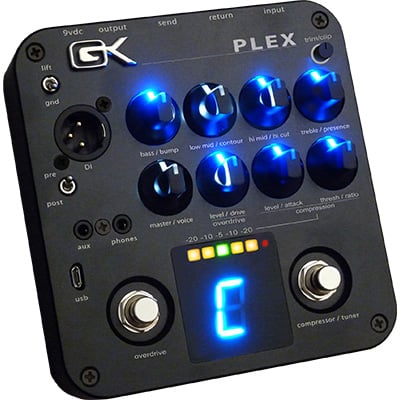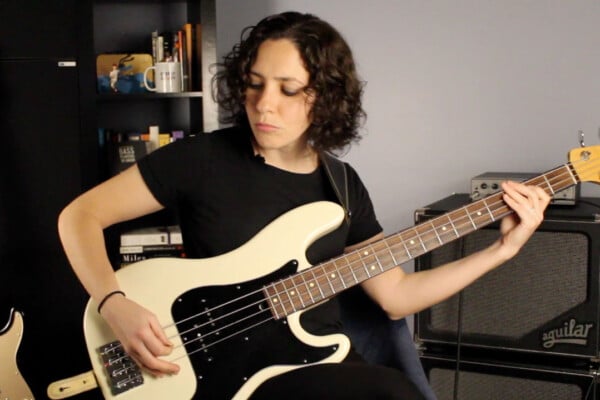Creative Bass Lines: Melodic and Rhythmic Lines

Creative Bass Lines is sponsored by Gallien-Krueger. GK’s Plex preamp combines 47 years of amp design experience with state of the art technology. Check it out.
For my first column here at No Treble, I thought it might be fun to demonstrate a few actual bass parts I have come up with for projects I have recorded.
One of the things I enjoy in the playing of the bassists that have influenced me is the use of interesting melodic and rhythmic devices – more often than not containing a rhythmic or melodic quirk that makes them stand out.
Think of Herbie Hancock’s great bass part on “Chameleon.” The chromatic ascending walk up to beat “one” makes that whole line move so beautifully. Consider too the simultaneous ascending and descending 10th in Lou Reed’s “Walk on the Wild Side” or Anthony Jackson’s incredible playing on Chaka Khan’s stuff or indeed with Steve Khan and Eyewitness.
So let’s look at some bass parts, and what makes them tick:
The first example (download PDF) is my intro and A section groove to “Drop the Chalupa” from the CPT Trio CD I recorded a few years ago. I wanted to write a bass part that placed the emphasis on the flattened 7th of the F dominant 7th chord, which almost disguises where the downbeat is. To get an idea of the sound, give the song a listen:
As the tune progresses it arrives at example two, which is a sample version of the bass part under the solos. Again, notice the E flat (the flat 7th of the F 7 chord) is a note I land on twice in the first bar and again in the second bar. There are also blues scale elements with the use of the flat third resolving swiftly up to the major third in both bars. Again, it’s possible to do this under a dominant chord, and it adds a little bit of ‘grease’ to the line.
Example three is a different beast altogether! Here, the concept is to have an EXTREMELY wide intervallic leap within the bass line. There’s also another brief moment of dissonance with the inclusion of a low “E” natural (the open E-string) against the tonality of F dominant 7th. The E is a half step away from both the chord’s flat 7th and it’s root as well!
Notice too the line starts with a pretty angular tritone shape moving from the flat 7th to major third back to flat 7th. I wanted to play off the tritone interval relationship between the third and flat seventh of the dominant chord this line supports.
Then comes that open E on beat two jumping up to an E flat and back to the E natural! It sounds strange on paper but I loved the brief dissonance the E gave me. It’s such a brief moment that it just catches the ear, hopefully without offending it!
It’s basically a two bar phrase, but I chose to vary the fourth bar to maintain some interest. Notice the use of chromatically ascending major tenths leading from the flat 7th (the E flat) up to the root of the chord (the F).
The use of tenths in a bass part is of course nothing new. Paul Jackson did this to great effect in the second recorded version of Herbie Hancock’s “Watermelon Man” Be sure to check out the contrary motion tenths in Lou reed’s “Walk on the Wild Side”, too.
And so we come to example 4. Here I use some simplified ideas from some of the French African bands I heard in Paris, such as Ultramarine. I wanted an upbeat Afro-funk idea with almost a guitar AND bass part combined. Notice the open A string, open D-string and (of course) open E in this line. It’s a simple I-IV-V progression, of course, but I wanted the interest to come from the dialogue between the low and high bass notes. You can even experiment with allowing the open A and D strings to ring somewhat. See what grabs your ear!
I’ve been fortunate to play with a lot of great musicians both in London, NYC and now LA where I reside. In New York particularly I was exposed to some amazing cats from Africa, Venzuela, Spain, Cuba, Brazil, Argentina, Uruguay, Puerto Rico and beyond. All of this ends up influencing me… sometimes directly, sometimes indirectly. Hopefully these parts might inspire you too!
Rufus Philpot is a performer and educator living in Los Angeles who has performed and or recorded with everyone from Scott Henderson, Allan Holdsworth, Virgil Donati and Tony MacAlpine to Randy Brecker, Tom Scott, Gary Novak and Marvin "Smitty" Smith. For more, check out his website.




Enjoyed it a lot. Thanks!
Any tips on how to modulate that open string + melody/tritone combo (say, going from E to F#) without having to jump between low and high frets? Or is the whole idea limited to using the open strings as the low notes?
hey isky! Glad you dug it….
As you guessed-the last exercise is very much utilizing the open strings-that was the point of that particular exercise…It’s actually the post solo bass part for a tune of mine called “Three’s A Crowd” which I plan on dissecting in full in possibly the next column! I particular wanted to use the open strings as a form of pedal point….
Thanks Rufus.
Perhaps it’s a bit unrelated but I’m curious about your “real time processing” when you play those (or any other, really) lines: is it pitches (A, B, etc..) or intervals (root, 5th, etc.) or both? Or neither? It’s one of my biggest problems: drifting away and losing track of what I’m doing, kind of a hit-or-miss autopilot mode
The audio is terrible on this clip
Wow, that’s nice. And, yeah, not really. It’s a bass lesson, not a record.
Great lesson, Rufus. Thanks!
Thanks Jesse. Glad u enjoyed it.
I enjoyed this very much and actually learned something.
Hallo
I would like to know if Santaniello Domenico is your endorser in italy and if he uses Gk410
He leves in mira, near Venice,
I wait for your answer
thanks
donatella donati
DOPE! Love section C!
Rufus: I have to say that while this column is for advanced players. I got a lot out of it in terms of structure and what a bass line idea is. You offer a terrific mix of oral clarity and playing expertise that gets your points across without being intimidating. Please let me know when the next No Treble column will be available.